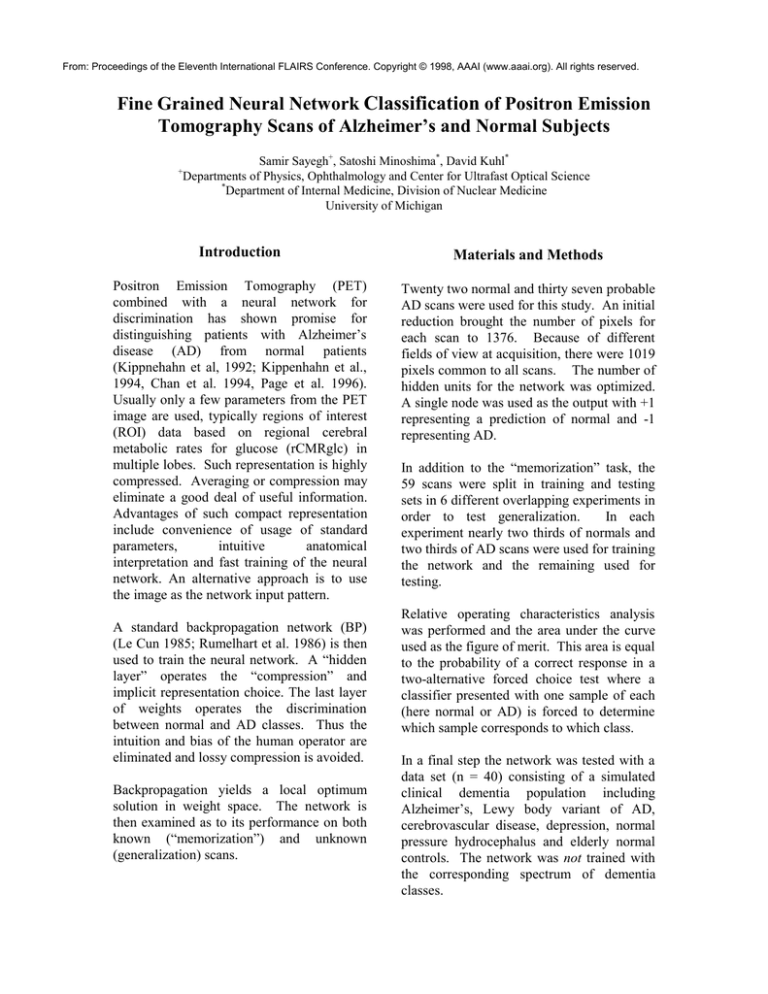
From: Proceedings of the Eleventh International FLAIRS Conference. Copyright © 1998, AAAI (www.aaai.org). All rights reserved.
Fine Grained Neural Network Classification of Positron Emission
Tomography Scans of Alzheimer’s and Normal Subjects
Samir Sayegh+, Satoshi Minoshima*, David Kuhl*
Departments of Physics, Ophthalmology and Center for Ultrafast Optical Science
*
Department of Internal Medicine, Division of Nuclear Medicine
University of Michigan
+
Introduction
Materials and Methods
Positron Emission Tomography (PET)
combined with a neural network for
discrimination has shown promise for
distinguishing patients with Alzheimer’s
disease (AD) from normal patients
(Kippnehahn et al, 1992; Kippenhahn et al.,
1994, Chan et al. 1994, Page et al. 1996).
Usually only a few parameters from the PET
image are used, typically regions of interest
(ROI) data based on regional cerebral
metabolic rates for glucose (rCMRglc) in
multiple lobes. Such representation is highly
compressed. Averaging or compression may
eliminate a good deal of useful information.
Advantages of such compact representation
include convenience of usage of standard
parameters,
intuitive
anatomical
interpretation and fast training of the neural
network. An alternative approach is to use
the image as the network input pattern.
Twenty two normal and thirty seven probable
AD scans were used for this study. An initial
reduction brought the number of pixels for
each scan to 1376. Because of different
fields of view at acquisition, there were 1019
pixels common to all scans. The number of
hidden units for the network was optimized.
A single node was used as the output with +1
representing a prediction of normal and -1
representing AD.
A standard backpropagation network (BP)
(Le Cun 1985; Rumelhart et al. 1986) is then
used to train the neural network. A “hidden
layer” operates the “compression” and
implicit representation choice. The last layer
of weights operates the discrimination
between normal and AD classes. Thus the
intuition and bias of the human operator are
eliminated and lossy compression is avoided.
Backpropagation yields a local optimum
solution in weight space. The network is
then examined as to its performance on both
known (“memorization”) and unknown
(generalization) scans.
In addition to the “memorization” task, the
59 scans were split in training and testing
sets in 6 different overlapping experiments in
order to test generalization.
In each
experiment nearly two thirds of normals and
two thirds of AD scans were used for training
the network and the remaining used for
testing.
Relative operating characteristics analysis
was performed and the area under the curve
used as the figure of merit. This area is equal
to the probability of a correct response in a
two-alternative forced choice test where a
classifier presented with one sample of each
(here normal or AD) is forced to determine
which sample corresponds to which class.
In a final step the network was tested with a
data set (n = 40) consisting of a simulated
clinical dementia population including
Alzheimer’s, Lewy body variant of AD,
cerebrovascular disease, depression, normal
pressure hydrocephalus and elderly normal
controls. The network was not trained with
the corresponding spectrum of dementia
classes.
From: Proceedings of the Eleventh International FLAIRS Conference. Copyright © 1998, AAAI (www.aaai.org). All rights reserved.
Results
Training with all 59 scans resulted in 100%
correct
classification.
This
clearly
demonstrates the viability of the approach
and the ability of an appropriately designed
network to discriminate normal PET scans
from AD scans.
On training and testing with distinct data
sets, ROC figures were consistently above
.95 with an average value of .97.
On the new data set of simulated dementia
population the sensitivity and specificity in
distinguishing AD and related diseases from
non-AD disorders were 95% (1 false
negative) and 63% (7 false positives),
respectively, with no inconclusive case.
False positives were observed most often in
cerebrovascular disease (5 out of 7).
Discussion
Neural Networks have shown success in a
variety of classification tasks including PET
(Kippenhahn, 1992). Preprocessing of the
data plays an important role in achieving
correct efficient classification.
Our results on the validation set compare
favorably to those of Kippenhahn and al.
whose neural networks area under ROC were
.85 compared to our > .95.
The
corresponding figure of merit for the human
reader reported by that group was .89.
As stated in Kippenhahn and al, three factors
need be considered in a PET-based
classification system: the intrinsic diagnostic
power of PET, the quality of the image
analysis and the classification method
(Kippenhahn et al. 1994). The present use of
pixel information for neural network input
improves the image analysis and is likely to
benefit the overall power of PET based
system. Our favorable results may be a
reflection of this fact.
Results of the simulated dementia population
indicate that a high sensitivity can be
achieved without training with all classes.
The inclusion of other disorders in the
training phase can only improve the
specificity of the classification.
References
Chan K, Johnson K, Becker JA, Satlin A,
Mendelson J, Garada B, Holman BL. A
Neural Network Classifier for Cerebral
Perfusion Imaging. J Nucl Med 1994;
35:771-774.
Kippenham JS, Barker WW, Pascal S, Nagel
J, Duara R. Evaluation of a Neural Network
Classifier for PET Scans of Normal and
Alzheimer’s Disease Subjects. J Nucl Med
1992; 33: 1459-1467
Kippenham JS, Barker WW, Nagel J, Grady
C, Duara R. Neural-Network Classification
of Normal and Alzheimer’s Disease Subjects
Using High-Resolution and Low Resolution
PET Cameras. J Nucl Med 1994; 35:7-15.
Le Cun, Y. 1985. Une 3URF GXUH
d’Apprentissage pour 5 VHDX[DSeuil
$VV\P WULTXH. In Cognitiva 85: A La
)URQWL UHGHl’Intelligence Artificielle des
Sciences de la Connaissance des
Neurosciences, CESTA, Paris.
Page M, Howard R, O’Brien J, BuxtonThomas and Pickering A. Use of Neural
Networks in Brain SPECT to Diagnose
Alzheimer’s Disease. J Nucl Med 1996,
37:195-200
Rumelhart,D.E., Hinton, G.E. and Williams,
R.J. 1986. Learning Internal Representations
by Error Propagation. In Parallel Distributed
Processing, Vol.1, Chap. 8, MIT Press.





